Infinite Space
| Infinite Space | |
|---|---|
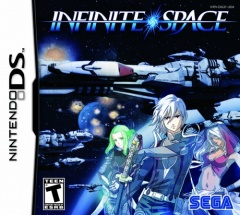 |
|
| Platforms | Nintendo DS |
| Genre | Infinitely awesome RPG |
| Score | 8  |
| Buy from Amazon | |
There is no reason I should have enjoyed Infinite Space.
Infinite Space is a 60 hour Japanese RPG released on the Nintendo DS earlier this year. This is exactly the kind of game I didn’t want to play anymore, but somehow found myself drawn into. I played, and I played, and I played some more until the end credits ran. Then I closed my DS and smiled.
It’s hard to quickly describe Infinite Space. Yes, it’s an RPG in space, which means lots of dialogue and battles. And yes, it was developed by a Japanese studio, called Nude Maker nonetheless (and slightly more amazing, published by Sega, who seemingly haven’t had a successful game in ages). I’ve had a recent aversion to JRPGs (which I documented extensively in April), but looking back, Infinite Space isn’t very Japanesey. The character art is drawn in the distinctive manga style, and there are random battles, but that’s about it. The story is actually comprehensible, and while heavy on the politics at times, features many identifiable and memorable characters.
Infinite Space is also kind of the epitome of what the First Hour is all about. It's a super long game that got the thumbs up after an hour from Paul Eastwood. I took his advice and went all the way.
Story
I’d like to start by saying that Infinite Space’s story is very good, it rivals the Mass Effect series in terms of scope and has just the right balance of serious science fiction and silly side characters. What sets it apart is that it has the balls to kill off major characters and experiment with some pretty trippy plot elements.
That isn’t to say the plot doesn’t get bogged down by its huge array of characters and extensive politicking. I had a hard time keeping track of who was allied with who, especially as the game wore on. The game tosses around leaders and planets and organizations without any kind of codex or encyclopedia to return to for help. The game also expects you to wander around a lot triggering the next event.
You might be able to chalk these plot structure stumbles up to the sheer amount of ambition crammed into this cart. It should be noted that the game’s story succeeds more often than it fails, by far. There are a few great twists and risky decisions on where to take the story, but there’s very little JRPG drudgery that plagued the last few titles I played in that genre.
The main plot is simple: you play as Yuri, a teenager trying to get off his oppressive planet and become a Zero-G Dog (basically a unaffiliated space pirate). You meet a friendly pilot who’s willing to take you off planet, and then the fun begins, you’d better start taking notes.
Gameplay
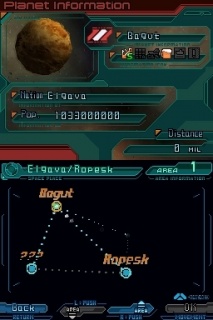 Being a big game, there are a few different types of gameplay that fill up Infinite Space. The centerpiece is, of course, the ship-to-ship battles. You take your homegrown fleet of spaceships and pit them against the fleet of nasty random-battle-pirates, hardened military strategists, or sympathetic royal family members. These battles are incredibly confusing for the game’s first hour, and the next few hours after that, which is something I’ll talk about in a bit in more detail, but by the end of the game they’re second hand and you will be dominating the battle field.
Being a big game, there are a few different types of gameplay that fill up Infinite Space. The centerpiece is, of course, the ship-to-ship battles. You take your homegrown fleet of spaceships and pit them against the fleet of nasty random-battle-pirates, hardened military strategists, or sympathetic royal family members. These battles are incredibly confusing for the game’s first hour, and the next few hours after that, which is something I’ll talk about in a bit in more detail, but by the end of the game they’re second hand and you will be dominating the battle field.
Space battles boil down to something like a rock-paper-scissor game where you can issue a normal attack that will always hit, a barrage that will hit for triple damage, or enter the dodge state which will always cause barrages to miss, but normal attacks will have a higher hit percentage. But it wouldn’t be a JRPG like battle without Infinite Space’s pseudo turn based combat which utilizes action points.
Before I go on, I realize I’m saying “pseudo this” and “something like that” a lot. This is because Infinite Space is very unique in almost everything it does, I can’t really directly compare it to anything else I’ve played. But this also causes some problems, the biggest is that the learning curve is HUGE. Multiple hours, possibly even ten of them passed before I felt comfortable with the battle system. I had to figure out the battle screen all by myself. What are those icons below the ships that go red and blue? Those are your weapons signifying whether they’re within firing range. What are those arrows below the enemy ships? That indicates where they are in their formation (a far left arrow means they’re in front, which means you’ll be able to hit them much more easily - think SNES-era Final Fantasy back and front options).
So once the battle system does sink in, there are still a lot of questions. What does the gauge speed stat do compared to battle speed? How does maintenance stat factor into battles besides repairing fighters? Most of these questions are never explicitly answered, adding to the confusion. But as your fleet grows in side and you upgrade your ships, modules, and weapons, things begin to fall into place and the little questions don’t seem to matter as much when the bigger ones are being answered.
My final notes on the battle system: fighters are great, I love how you can escape from nearly every random battle without even entering the battle screen, and the amount of damage you are receiving and dealing should have been delivered in a lot more efficient manner (you sit and watch a 30 second cutscene of your ship attacking theirs and the hit points slowly tick away).
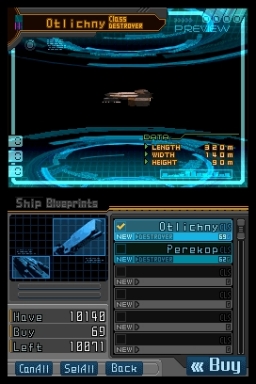 But outside the battle system, there is a heckuva lot more going on! Serving as the structure for the game is the epic tale Nude Maker wants to tell, so there is a lot of text to read through. A lot. If you’re adverse to reading, might as well back away right now (though if you’re adverse to reading, you’re probably not 1000 words into a review as it is). A lot of optional text too, you can visit planets, head to their tavern, talk to the barkeep to pick up a mission, speak with random strangers in the tavern, and even visit parks, headquarters, and pirate bases at some locations.
But outside the battle system, there is a heckuva lot more going on! Serving as the structure for the game is the epic tale Nude Maker wants to tell, so there is a lot of text to read through. A lot. If you’re adverse to reading, might as well back away right now (though if you’re adverse to reading, you’re probably not 1000 words into a review as it is). A lot of optional text too, you can visit planets, head to their tavern, talk to the barkeep to pick up a mission, speak with random strangers in the tavern, and even visit parks, headquarters, and pirate bases at some locations.
The surprising thing is, Infinite Space is incredibly well translated. For a game boasting thousands and thousands of words, nothing ever jumped out at me for being incomprehensible. I don’t even remember any spelling or grammatical errors! Great job Sega on that one.
Probably the deepest and most intriguing gameplay element in Infinite Space is customizing your ships. Essentially you buy a ship, and it comes equipped with the bare essentials of an engine and bridge. It’s up to you to fill in the rest. A ship is made up of a bunch of squares that you fit modules into. Think of it as Tetris, but not only are you trying to optimize the space, but you’re also trying to optimize the types of modules you place in. Maybe you want to upgrade your engine, but the better one takes up four squares instead of two, limiting you in the number of hangars you can buy. This is easily the deepest part of the game, and I looked forward to buying a new ship just so I could outfit it with the latest goodies.
Customizing your own ship gives your fleet a personal touch. I focused on fighters and defense at the end of the game, and my fleet was designed optimally for that strategy. Others might like pure offense, or buy some shield ships to soak up damage, the options really are infinite.
Similar to ship outfitting, you also need to assign a crew. There are something like 40 jobs available in your fleet, from artillery to head cook to janitor. All play important roles and affect battles, melees, or travel efficiency in some way. At the beginning of the game you’ll be constantly frustrated with traveling long distances (as the longer you’re away from port, the slower your action points will refill in battle), but as your crew is fleshed out and you can buy better modules, you’ll never need to worry about it.
Optimizing your crew is actually pretty difficult, as at the end I probably had about 60+ characters available to me to fill about 40 roles, and each character has their own set of 10 stats and abilities. While not as cool as designing the innards of your ship, crew management is important to the game and pretty enjoyable.
 While most of the gameplay elements are successful and fun, two stumble out of the gate and never recover. The first is the melee battle. In nearly every ship battle, you have the option of approaching the enemy fleet and boarding their ship. You’ll then fight in a real rock-paper-scissors game of slash-shoot-leader. It’s played in real time though with weird delays and special moves, and is incredibly confusing. The first time I played it was for a story melee battle, and I lost within seconds. Upon reloading, I won within seconds. While I eventually figured out more or less what was going on, they still seemed too random. I never purposefully melee battled anyone, and outside the story battles, was never brought into them by the enemy. So basically they become they pointless addition that can be easily winnable with some Level 5 Security Offices on all your ships whenever you know there will be a battle.
While most of the gameplay elements are successful and fun, two stumble out of the gate and never recover. The first is the melee battle. In nearly every ship battle, you have the option of approaching the enemy fleet and boarding their ship. You’ll then fight in a real rock-paper-scissors game of slash-shoot-leader. It’s played in real time though with weird delays and special moves, and is incredibly confusing. The first time I played it was for a story melee battle, and I lost within seconds. Upon reloading, I won within seconds. While I eventually figured out more or less what was going on, they still seemed too random. I never purposefully melee battled anyone, and outside the story battles, was never brought into them by the enemy. So basically they become they pointless addition that can be easily winnable with some Level 5 Security Offices on all your ships whenever you know there will be a battle.
The other wasted gameplay element are the indoor exploration sequences. There’s a few sequences in Infinite Space where you navigate a building to rescue someone or fight some boss. Unfortunately, these events are simply crammed into the text/selection engine, so you click the Forward response when you want to go forward... and that’s usually the only option. Sometimes you’ll fight a melee battle, sometimes you’ll find some cash, but most of the time you just keep selecting Forward while watching the same, lame cutscenes of hallways and doors, over and over again. I’m curious if they were originally going to attempt something much bigger and just fell short, or if this piece of crap is what they actually intended. Either way, in a 60 hour game you probably only navigate about 15 of these, so not a lot of time lost.
Graphics
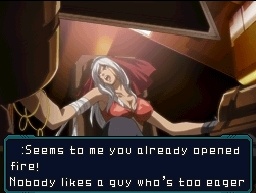 With so much text, menus to navigate, and battles to be won, you would hope that Infinite Space is pretty easy on the eyes. Thankfully, it is, and I think I’m able to appreciate the minimalist method the developers took with things due to my experience with games like Phoenix Wright. In the Ace Attorney series, everything and everyone is over the top. Every line of dialogue is accompanied by some outrageous toupee-bouncing animation. While cute, this can grow old quickly after a few hours. Infinite Space chooses to go with the static picture route. While speaking, there’s a single picture of that person talking. They’re not sliding in and out of the screen, just coming and going as the conversation dictates. Simple, thankfully.
With so much text, menus to navigate, and battles to be won, you would hope that Infinite Space is pretty easy on the eyes. Thankfully, it is, and I think I’m able to appreciate the minimalist method the developers took with things due to my experience with games like Phoenix Wright. In the Ace Attorney series, everything and everyone is over the top. Every line of dialogue is accompanied by some outrageous toupee-bouncing animation. While cute, this can grow old quickly after a few hours. Infinite Space chooses to go with the static picture route. While speaking, there’s a single picture of that person talking. They’re not sliding in and out of the screen, just coming and going as the conversation dictates. Simple, thankfully.
The manga-styled characters are all well drawn and actually look like real people. There’s nothing too outrageous here until near the end of the game, as if you needed a reminder that you’re playing a science fiction title. The menus are simple to navigate but aren’t always the most responsive. Sometimes it seems like objects needed multiple tappings before they gained focus.
The spaceships in Infinite Space range from forgettable to wow-now-that’s-creative, but considering how there are more than 100 fully customizable ships in the game, I can really appreciate the amount of work that went into their design. Each ship is modeled in 3D and while they’re not stunning to look at, it gets the job done and there’s a great sense of scale. Battleships take up the whole screen and fighters are not even visible.
The fights themselves are simple to watch, and are probably an almost all-too-real look at what space battles might look like in the future: huge battleships blasting at each other from hundreds of kilometers away. You’ll never see any dogfighting or evasive maneuvers, but the battle system is complex enough! The ships do blow up very nicely though and their blown out hulls stay on the battlefield as a grim reminder of war.
Sound
Musically, I’m sad to admit that I played most of this game with the volume off. If you’re going to play a 60 hour game, a lot of it is going to be late at night, which for me means either headphones or nothing. The music I did hear sounded good enough, but the klaxons blaring before every random battle got annoying way too quickly. Yes, yes, red alert, battle stations, tea, earl grey, hot.
Summary
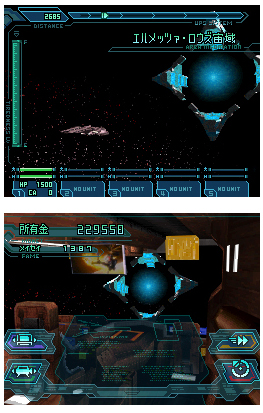 After way too much text already, here’s my attempt at summarizing it up (quickly?).
After way too much text already, here’s my attempt at summarizing it up (quickly?).
What I loved: Epic, epic storyline that takes on series like Mass Effect, and even beats them at times with the risks it takes. The ending leaves some of the story up to interpretation which worked awesome for Infinite Space. Very well translated game too.
Great cast of characters with some excellent progression. The mid-game twist is ballsy but totally pays off in terms of character growth. The only problem is that there are way too many C and D level important characters that started to merge together in my mind.
Fun battle system with, yes, an infinite amount of customization and creativity at your fingertips. Installing modules into your ship is a blast.
What I liked: While the game features random battles, 80% of them are immediately escapable. And the best part? Infinite Space requires absolutely no grinding.
Crew management gets to be a bit tedious near the end of the game with so many people to fit into so few slots. Plus I never understood why characters leveled up.
What I didn’t like: Wasted opportunity with the dungeons, they either shouldn’t have been there at all, or been more fleshed out.
Melee battles were kind of a mess, not sure how they could have been better though without removing them from the game.
Some battles could become tedious when they became more of a war of attrition than actually gunning it out. But a lot of this depends on how you design your fleet too and what types of strategy you will focus on.
What I hated: That red alert klaxon that goes off before every battle. STOP IT!
Scores
Gameplay: 8
Fun Factor: 8
Graphics and Sound: 7
Story: 10
Overall: 8
Infinite Space is a great game but it is definitely not for everyone. This is the type of game that maybe only 10% of gamers who play it will progress far enough to enjoy it, and 10% of those will actually play long enough to beat it. But for that 1% gamer, the elusive guy like me that even though he can’t stand JRPGs right now but still played through two and a half real time days of one, well, Infinite Space is your game.
